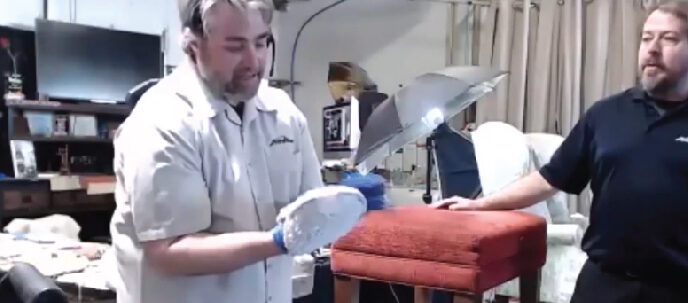The Goal of Upholstery Cleaning
In pursuing how to properly clean upholstery, we learn about how upholstery is  constructed; i.e., we learn about fiber content, weaves, finishes, and construction of the fabric can all affect the outcome of the cleaning. You have to be concerned about the quality of your cleaning results (usually appearance improvement); shrinkage; browning; yellowing; weak or fugitive dyes that may bleed; spots and stains; and change in the texture of the fabric.
constructed; i.e., we learn about fiber content, weaves, finishes, and construction of the fabric can all affect the outcome of the cleaning. You have to be concerned about the quality of your cleaning results (usually appearance improvement); shrinkage; browning; yellowing; weak or fugitive dyes that may bleed; spots and stains; and change in the texture of the fabric.
Your expertise in carpet cleaning gives you an excellent base knowledge to move on to upholstery cleaning, but it does not make you expert upholstery cleaner. One reason for this is that with carpet you are dealing with only a few fibers or blends, and there are only a few basic methods of carpet construction. In furniture cleaning, the fibers, blends, and construction of the fabric are much more varied, (in fact most upholstery fabrics are blends of more than one fiber).
You will have to be aware of many more possibilities when cleaning upholstery than with carpet. Where carpets are tougher and meant to handle years of abuse, most  furniture fabrics are delicate and designed for their decorative effect rather than their durability and “cleanability”. We say this not to scare you, but to make you aware that a little added expertise is required to handle most of today’s furniture fabrics. When it comes to pre-testing and cleaning upholstery, you have one main goal: remove as much soil as possible, without changing the color or texture of the fabric. If you forget this, and you are too aggressive, you may find yourself in a situation that is difficult to correct. Perhaps even more importantly, the goal of upholstery cleaning, like any service you provide has to be to make money doing it. To quote one of my mentors, industry instructor, Doug Bowles, you need to “make money, while staying out of trouble.”
furniture fabrics are delicate and designed for their decorative effect rather than their durability and “cleanability”. We say this not to scare you, but to make you aware that a little added expertise is required to handle most of today’s furniture fabrics. When it comes to pre-testing and cleaning upholstery, you have one main goal: remove as much soil as possible, without changing the color or texture of the fabric. If you forget this, and you are too aggressive, you may find yourself in a situation that is difficult to correct. Perhaps even more importantly, the goal of upholstery cleaning, like any service you provide has to be to make money doing it. To quote one of my mentors, industry instructor, Doug Bowles, you need to “make money, while staying out of trouble.”
Part of learning how to correctly clean upholstery lies in learning how to identify the fiber content itself. There are plenty of reference articles out there about how to do a burn test or chemical test to do this. Keep in mind, however, that identification of the fiber content is not the only prerequisite for cleaning that fabric. Trying to identify a blended fabric by burn testing can be confusing. Try testing a nylon-rayon blend with a cotton backing coated with latex for stability, and let us know how it comes out.
It is important to know that you can clean a fabric successfully without knowing the exact fiber if you follow the basic rules of cleaning, and if you TEST your cleaning method to be sure that it is safe for that piece. Pretesting is important because it provides useful information about dyes, finishes, and construction.
So very often it is important to come back to the basic goal of upholstery cleaning: remove as much soil as possible, without changing the color or texture of the fabric. With this as our main driving factor, regardless of the fabric being cleaned, there are three important rules you can remember in cleaning upholstery.
Control your moisture – Many cleaning related problems are directly related to over-wetting. You should always avoid over-wetting. Use the proper tools and cleaning procedures and you can avoid most of these problems. The best way to do this is to either use a low moisture upholstery cleaning tool, or even better use a shearing effect tool that  cleans across the face of the fiber rather than shooting water down into it like the HydraMaster DriMaster 3 Upholstery tool. Issues related to cleaning upholstery can be dramatically reduced simply by using the DriMaster 3.
cleans across the face of the fiber rather than shooting water down into it like the HydraMaster DriMaster 3 Upholstery tool. Issues related to cleaning upholstery can be dramatically reduced simply by using the DriMaster 3.
Control your pH – Too high of pH can cause bleeding, browning, and other types of problems. Most times you will be using a mild alkaline, and at times a neutral or even an acid chemical may be needed. You would not clean upholstery with your carpet scrub wand. It is usually better not to use your carpet cleaning chemicals to clean upholstery with either. Products specifically formulated for upholstery cleaning like HydraMaster-CleanMaster FabricMaster Fine Fabric,  FabricMaster HD, WoolMaster, Natural Orange and Rinse-Out are specifically formulated for the specific soils that characterize upholstery soiling.
FabricMaster HD, WoolMaster, Natural Orange and Rinse-Out are specifically formulated for the specific soils that characterize upholstery soiling.
Speed up your drying – Most problems occur during the drying step, not instantly. By
reducing the dry time of the fabric, you will greatly reduce the chance of bleeding, browning, or wicking. An air mover can be your best friend in cleaning upholstery. Your technicians are much more likely to use a lighter weight, easier to carry airmover like the HM1000 Micro Airmover from HydraMaster.
For specific how to step by step instructions on many of the most commonly encountered upholstery fabrics, see our hands-on upholstery cleaning reference guide by clicking here.
Tags: blend fabrics, blend fibers, browning, carpet cleaning, fabric, fiber weakness, fibers, protect upholstery, shrinkage, upholstery, weaves, yellowing





